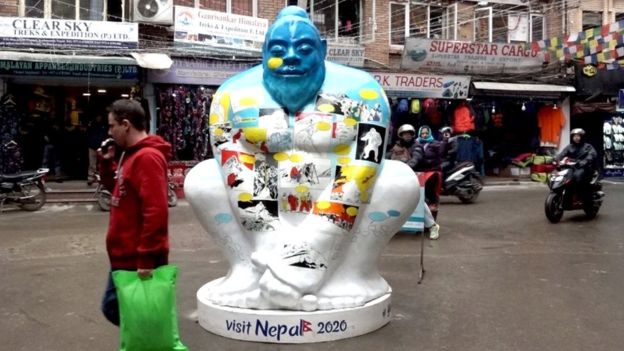
A row over a mythical creature has pitted experts against officials – and, for once, it is not about whether or not the aforementioned creature actually exists.
Instead, it is how the creature looks.
“This is not right. The government can’t just do as it wants,” passer-by Reshma Shrestha says, shaking her head in front of the 7ft (2.1m) tall statue at the centre of a row.
“If you did not tell me, I would not have known that it was a yeti.”
‘It’s a sumo wrestler’
The arrival of the first of more than 100 statues emblazoned with the words “Visit Nepal” was supposed to be the start of a year-long celebration of what the small Himalayan nation had to offer to the outside world.
They will soon be popping up across the country – at popular tourist attractions, trade centres, airports and some of the base camps in the Himalayas – as well as travelling further afield to act as mascots in cities around the world.
But the launch of the tourism drive, which aims to bring two million tourists to the region, has been somewhat overshadowed by the row over the statues’ appearance.

“In folk tales, the yeti has been described as a big monkey-like creature,” Ram Kumar Pandey tells the BBC. “However, the recent logo depicts it as a sumo wrestler. This does not at all match with the mythical character that has been described in many folk tales.”
And Pandey should know: the author of several books on the subject, his objections are supported by other Nepalese cultural historians.
In fairness, most Nepalis are experts when it comes to the yeti, a mythical beast which lives in the Himalayas and features in many of the country’s folk tales. And they are unimpressed.
“What I know about the yeti is that it is a monkey-like creature, which walks around in snow,” Reshma continues, analysing the figure in front of Kesar Mahal in the capital Kathmandu, unconvinced by what has been created.
Krishna Lama is more blunt.
“It looks like a wrestler – not a yeti,” he tells BBC Nepali.

However, the Yeti Art Committee – a subdivision of the Visit Nepal Year secretariat – is standing by its yetis, which don’t come cheap at a cost of 500,000 rupees ($4,414; £3,380) apiece.
The group’s co-coordinator, Prem Prabhat Gurung, says because the yeti is a mythical character, there should be creative freedom.
“Our aim is to produce the yeti as an emblem of peace, reconciliation and humility rather than a fear-creating feature,” he tells the BBC. “People around the world should not only know Nepal as the land of Everest or Lord Buddha or Gurkha. The yeti can represent our uniqueness as well.”
Ang Tsherin Sherpa – the man responsible for the controversial design – is equally defiant.
“I did not make yeti’s sketch by reading any book,” he explains. “On the basis of stories that I heard in my childhood, and having Lord Buddha at the back of my mind, I made the design.”
There was, however, at least one more practical reason behind his choice: Sherpa says he did not make it furry as depicted in yeti-related literature in order “to make it easier to paint”. (BBC)





